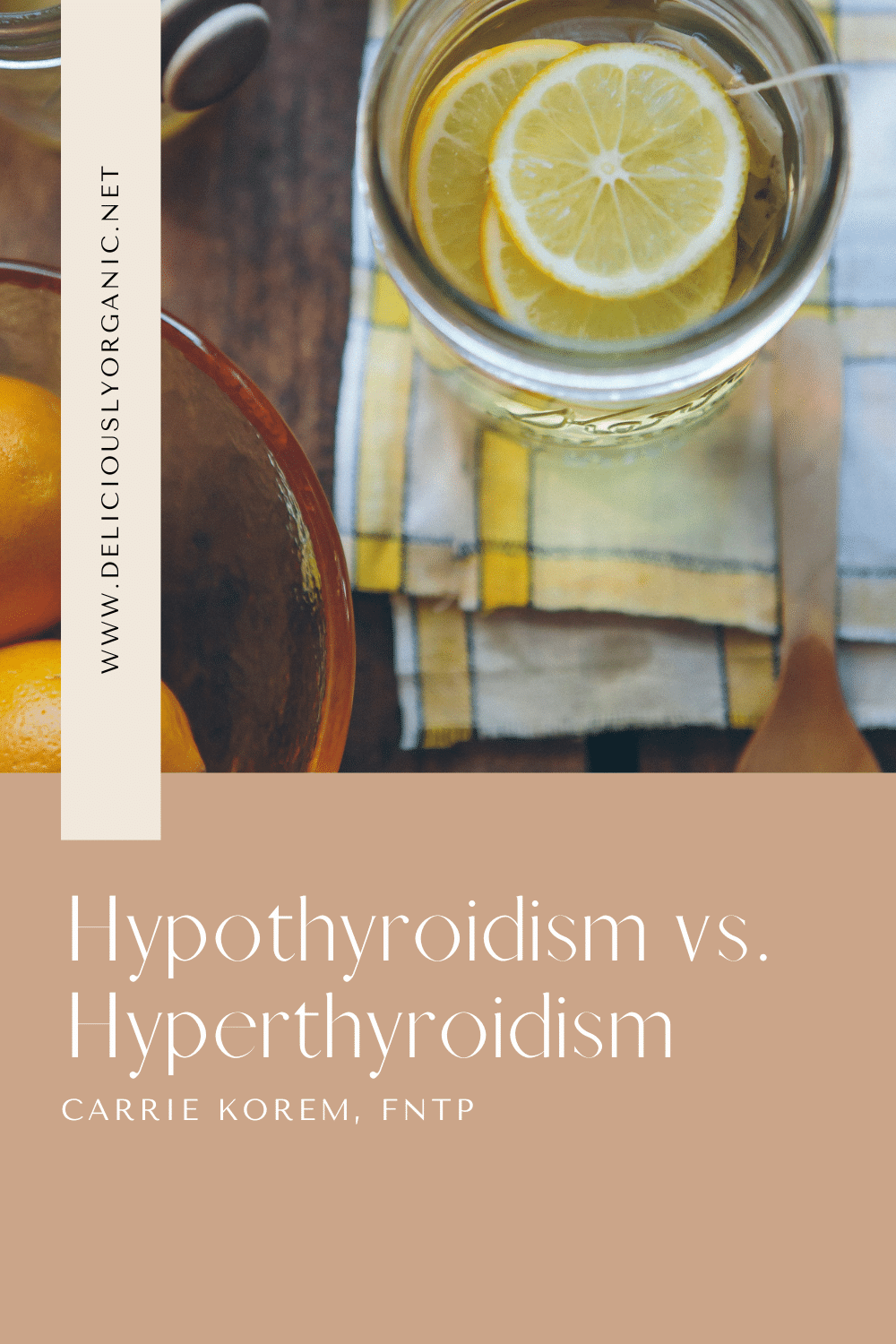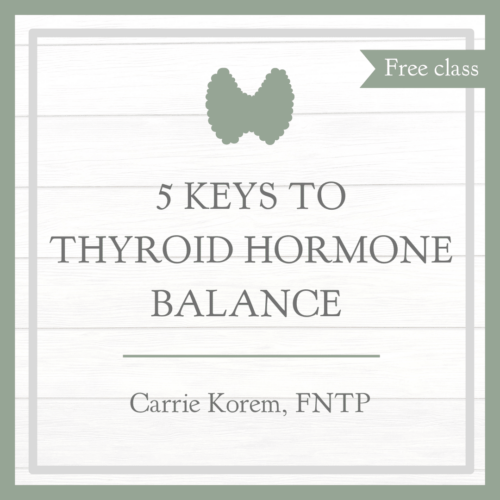The two most common types of thyroid disorders are hyperthyroidism and hypothyroidism. While they sound similar, they are actually very different. Let’s walk through hypothyroidism vs. hyperthyroidism.
What is hyperthyroidism (over active thyroid)?
Hyperthyroidism happens when the thyroid gland makes too much thyroid hormone. This condition is also known as overactive thyroid. Hyperthyroidism speeds up the body’s metabolism.
How is hyperthyroidism diagnosed?
Hyperthyroidism is most often diagnosed when TSH (thyroid stimulating hormone) levels are low and free T4 and/or free T3 levels are high.
It is common for someone to be diagnosed hyperthyroid by only testing TSH (a pituitary hormone). So, it is always recommended to get a full thyroid panel so you can know if your thyroid hormones such as fT4 and fT3 are also elevated.
What Causes Hyperthyroidism?
In the holistic world, we see that the two most common root causes for hyperthyroidism is chronic stress and/or toxicity in the body.
Also, the root cause depends on which level is high or low, so let’s take a look at those:
If TSH is low:
The pituitary, hypothalamus and adrenals (also called the HPA axis) are all part of the endocrine system and communicate with one another throughout the day. When the body perceives stress (for those with hyperthyroidism, this is usually in the form of emotional or environmental stress), the hypothalamus tells the pituitary to produce less TSH so the thyroid will produce more hormones to keep the body functioning.
So, a low TSH level doesn’t always indicate a thyroid hormone issue. Instead, it’s often an imbalance in the HPA axis. Your practitioner’s job is to now figure out why there is an imbalance.
If free T4 is high:
- Most often, free T4 is high because there is a severe form of emotional or environmental stress (from things such as synthetic pesticides, toxic heavy metals, and possibly glyphosate).
- FT4 can also be elevated because TSI is mimicking TSH and telling the thyroid to make excess FT4.
- There is also a negative feedback loop between TSH and FT4, so sometimes FT4 can be elevated when TSH is too low.
- Free T4 can also be elevated if you happen to be on too much thyroid hormone replacement, so it’s always good to talk to your doctor or pharmacist about this possibility.
- fT4 can be elevated from overactive thyroid nodules.
If free T3 is high:
Here are a few reasons why FT3 can be too high:
1. The thyroid is making too much T4 that is being converted to FT3.
2. When there is toxicity somewhere in the body, this can increase FT3.
3. Being on too much thyroid hormone can also cause elevated FT3, so it’s always good to talk to your doctor or pharmacist about this possibility.
What are the symptoms of hyperthyroidism?
Here’s a list of some of the most common symptoms:
- Nervousness
- Irritability
- Increased sweating
- Heart racing
- Hand tremors
- Anxiety
- Difficulty sleeping
- Thinning of your skin
- Fine brittle hair
- Increased sensitivity to heat
- Weakness in your muscles—especially in the upper arms and thighs.
- More frequent bowel movements
- Weight loss
- Excessive appetite
- Irregular Menstrual cycles
- Lots of energy (often too much)
- Lack of energy (as the body breaks down)
- Bulging Eyes
- Goiter
- Graves Disease
When to see a doctor
Always work with a doctor when you have hyperthyroidism. The body is in a state of overdrive and it’s so important to be closely monitored.
I’ve worked with many clients who were diagnosed with hyperthyroidism and they were under the care of their doctor while we worked together on their root causes. You can take holistic and conventional steps for your thyroid at the same time!
Can you take holistic steps for Hyperthyroidism while working with a doctor?
Yes! In this article, I list 10 steps you can take to reduce hyperthyroidism symptoms naturally.
What is hypothyroidism?
Hypothyroidism happens when the thyroid gland doesn’t make enough thyroid hormone. This condition also is called underactive thyroid.
What Are the Symptoms of Hypothyroidism?
There are actually hundreds of symptoms, but here’s a list of some of the most common:
Feeling tired
Anxiety
Thinning or loss of outer third of eyebrows
Depression
Weight gain
Feeling cold
Irritability
Hair loss or thinning
Weakness and aches in muscles and joints
Itchy and dry skin
Difficulty concentrating
Brain fog
Constipation
Heavy or irregular periods
Puffy face
Hoarseness in the voice
Muscle weakness
Elevated cholesterol
Slowed heart rate
Low blood pressure
Insomnia
Brittle nails
Muscle loss
Low libido
Infertility and miscarriage
Lack of motivation
Digestive issues
Low vitamin D
Low B12
Weak immune system
Low ferritin (or anemia)
Needing a nap in the afternoon
Chronic fatigue
Diminished appetite
Low basal body temperature
Frequent infections
Lump in throat
How is Hypothyroidism Diagnosed?
Hypothyroidism is most often diagnosed when TSH (thyroid stimulating hormone) levels are elevated, free T4 levels are low and/or free T3 levels are low. But, oftentimes a doctor will diagnose a patient with hypothyroidism when they see just high TSH levels.
What Causes Hypothyroidism?
This really depends on which level is too high or too low, so let’s break this down.
If TSH is elevated:
TSH is a hormone that the pituitary sends out to tell the thyroid how much or how little thyroid hormones to produce.
The pituitary, hypothalamus and adrenals (also called the HPA axis) are all part of the endocrine system and communicate with one another throughout the day. When the body perceives stress – emotional, mental, physical, environmental, mental, stress from disease, etc. – the hypothalamus tells the adrenals to work harder to put out additional cortisol, and it tells the pituitary to crank out more TSH so the thyroid will slow down.
So, a high TSH level doesn’t always indicate a thyroid problem. Instead, there’s some sort of imbalance in the HPA axis. Your practitioner’s job is to now figure out why there is an imbalance.
If fT4 is low:
Most often, free T4 is low because the thyroid doesn’t have the resources to produce the proper amount of T4. The thyroid needs iodine and tyrosine to produce thyroid hormones. Increasing the consumption of iodine-rich foods, reducing exposure to chlorine, fluoride and bromine (this is incredibly important!), and taking an iodine supplement can often help improve this imbalance.
If you’re concerned about taking iodine when you have thyroid disease, read this post and it should answer your questions.
Free T4 can also be low when thyroid antibody levels are elevated. When antibodies attack the thyroid tissues, this can make it difficult for the thyroid to produce enough fT4.
Another common cause of low FT4 is anemia. The body needs iron to make TPO, which is then used to make a thyroid hormone (FT4). When the body is deficient in iron, FT4 levels can drop, putting the body in a hypothyroid state. To read more about this, and see what steps you can take to reverse the issue, click here.
Three common reasons why free T3 can be low:
1. Free T3 can be low because there isn’t enough free T4 being produced by the thyroid to be converted into free T3.
2. If there are adequate levels of free T4, but there isn’t enough free T3, then this often indicates liver congestion.
Let me explain. . .
Your thyroid produces T4 and sends most of it to the liver to be converted into the active form, free T3. If you have enough free T4, but not enough free T3, then you don’t necessarily have a thyroid problem, instead, you may need to support your liver so it can efficiently convert T4 to T3 for you.
Liver congestion is pretty common nowadays, and can not only cause low T3 in the body, it also can cause estrogen dominance, severe headaches, blood sugar imbalance, chemical sensitivities, skin issues, and dark circles under the eyes, among other things. Here is an article I wrote with specific steps you can take to improve this issue.
3. Free T3 can also be low because there is excess cortisol (from adrenal imbalance) that is blocking the conversion of free T4 to free T3 and instead creating an excess of reverse T3.
How do doctors treat hypothyroidism?
Most often, they treat hypothyroidism with thyroid hormone replacement. Some patients will be prescribed T4, some T3 and some will be given a combination of T4 and T3.
Of course, always talk to your doctor about the best treatment plan for your situation.
Can you take holistic steps for Hypothyroidism while working with a doctor?
Yes! In this article, I list 10 steps you can take to reduce hypothyroidism symptoms naturally.
If you’d like to learn from first steps you can take to help support your thyroid, check out my class, “3 Keys to Thyroid Hormone Balance”. It’s just 45 minutes and I promise you’ll learn something new!
___________________________________________________________________________
Disclaimer: The purpose of this post is to give an overview of hypothyroidism and hyperthyroidism from a holistic perspective. Due to biochemical individuality there can be many various reasons for the root causes of thyroid disease, and many ways to help improve thyroid in balance in the body. This information is not intended to take the place of your doctor’s advice.




